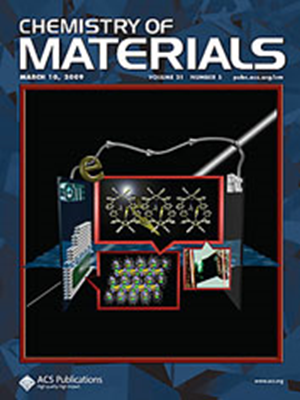溴诱导抑制混合阳离子混合卤化物过磷酸盐的低温相变
IF 7
2区 材料科学
Q2 CHEMISTRY, PHYSICAL
引用次数: 0
摘要
混合阳离子混合卤化物铅包晶石已被证明是太阳能转换的绝佳候选材料。然而,了解这些混合离子过氧化物在各种工作温度下的结构相至关重要,其中包括用于太空应用的超低温。在本研究中,我们利用低温原位同步辐射粉末 X 射线衍射研究了甲脒基 CsyFA1-yPb(BrxI1-x)3 的结构。我们的研究结果表明,在混合阳离子(Cs,FA)包晶石中用 Br 替代 I 阴离子可抑制低温下从四方到正方的相变。加入 Br 还能阻止非包晶石次生相的形成。通过绘制混合阳离子混合卤化物组成集的低温相图,我们对这些材料的结构行为有了基本的了解。对结构特性的了解为设计出更坚固、更高效、能在极端温度条件下工作的能源材料奠定了基础,包括天基太阳能转换。本文章由计算机程序翻译,如有差异,请以英文原文为准。

Br-Induced Suppression of Low-Temperature Phase Transitions in Mixed-Cation Mixed-Halide Perovskites
Mixed-cation mixed-halide lead perovskites have been shown to be excellent candidates for solar energy conversion. However, understanding the structural phases of these mixed-ion perovskites across a wide range of operating temperatures, including very low temperatures for space applications, is crucial. In this study, we investigated the structure of formamidinium-based CsyFA1–yPb(BrxI1–x)3 using low-temperature in situ synchrotron powder X-ray diffraction. Our findings revealed that substituting the I anion with Br in mixed-cation (Cs,FA) perovskites suppressed the phase transformation from tetragonal to orthorhombic at low temperatures. The addition of Br also prevented the formation of nonperovskite secondary phases. We gained fundamental insights into the structural behavior of these materials by creating a low-temperature phase diagram for the compositional set of mixed-cation mixed-halides. This understanding of the structural properties lays the groundwork for designing more robust and efficient energy materials capable of functioning under extreme temperature conditions, including space-based solar energy conversion.
求助全文
通过发布文献求助,成功后即可免费获取论文全文。
去求助
来源期刊

Chemistry of Materials
工程技术-材料科学:综合
CiteScore
14.10
自引率
5.80%
发文量
929
审稿时长
1.5 months
期刊介绍:
The journal Chemistry of Materials focuses on publishing original research at the intersection of materials science and chemistry. The studies published in the journal involve chemistry as a prominent component and explore topics such as the design, synthesis, characterization, processing, understanding, and application of functional or potentially functional materials. The journal covers various areas of interest, including inorganic and organic solid-state chemistry, nanomaterials, biomaterials, thin films and polymers, and composite/hybrid materials. The journal particularly seeks papers that highlight the creation or development of innovative materials with novel optical, electrical, magnetic, catalytic, or mechanical properties. It is essential that manuscripts on these topics have a primary focus on the chemistry of materials and represent a significant advancement compared to prior research. Before external reviews are sought, submitted manuscripts undergo a review process by a minimum of two editors to ensure their appropriateness for the journal and the presence of sufficient evidence of a significant advance that will be of broad interest to the materials chemistry community.
 求助内容:
求助内容: 应助结果提醒方式:
应助结果提醒方式:


